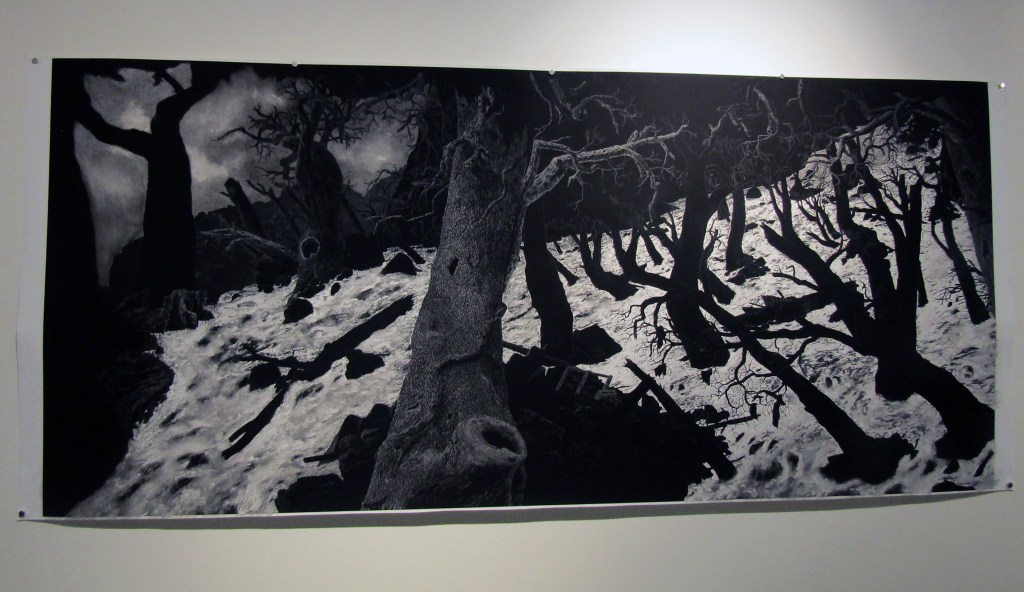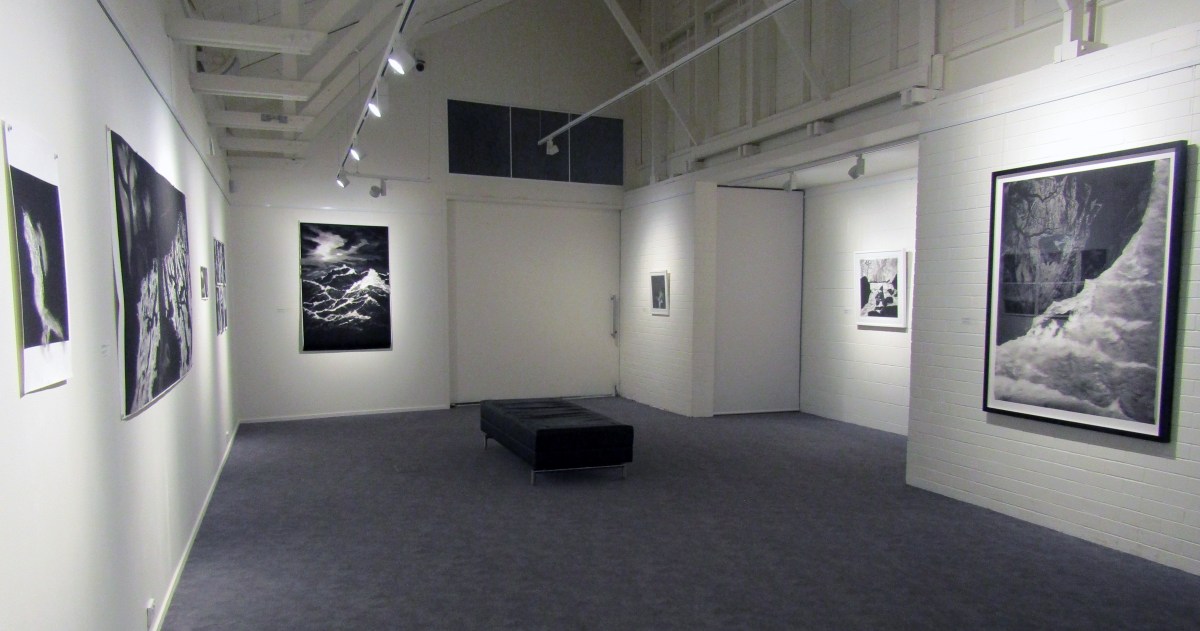Still Water features a spectacular selection of landscapes, hewn into digitally printed Hahnemühle paper, by Dutch artist Henri van Noordenburg between 2011 and 2023. The artworks in this introspective series have been extensively exhibited; some were included in the group exhibition Abacus at Ingrid Duess Gallery in Belgium in 2022. Others formed part of a solo exhibition at Galerie Kunstkomplex in Germany in 2019. According to the artist, however, critiques of this series in the Australian art media have been limited. This could be due to Noordenburg’s technique – a process he likens to sgraffito – which defies easy definition.
Each titled Composition plus a Roman numeral, many of the artworks in this series began as photographs, including self-portraits like Composition XV (2012). The artist strips the surfaces of each print into desolate environments, which are monochromatic except for the faint flesh tones of his unclothed likenesses. He depicts himself in a variety of modes of survival, including clinging to a cliff face in Composition LIX (2020). There is a complete absence of figures in the more inhospitable of the imagined terrains. In Composition XCVII (2023), it appears that Noordenburg has retreated outside of the picture plane. Viewers share his vantage point of looking at the waves as opposed to seeing him in the composition as a subject.
Over the decade of tableaux, viewers seem to witness changes in the internal realities experienced by the artist. They could represent a journey that began in mountainous woodland terrain, traversed treacherous rivers and reached a tumultuous ocean. An alternative reading, in light of climate change, could place the viewer stationary in altitude, with the water rising, and the land being consumed by the sea. Irrespective, the soft hues of bouquets peculiarly placed among water rapids, like the magenta tulips in Composition XCVI (2023), offer momentary reprieves in an otherwise unyielding set of scenes.

The series is filled with personal allegories. However, it also represents a reverence of, yet vulnerability to, nature that should resonate among audiences. Some of the artworks, like Composition L (2018-2020) combine conflicting natural and architectural elements, such as rivers and aqueduct-like arches. It is unclear which is the pervading force, whether the water is being conducted, the structure is being eroded, or both.
Like the sgraffito technique, which involves scratching back the surface layer of the paper, Noordenburg appears to have also peeled back pretences about his own gender. The Home of the Arts (HOTA) recently showed a scrum of wheelbarrows on an improvised football field by Yuriyal Eric Bridgeman. The Queensland Art Gallery I Gallery of Modern Art (QAGOMA) is currently holding an exhibition with hyperrealist depictions of cars, cowboys and cocks of the avian variety by Michael Zavros. Both artists, who identify as male, are building upon and exceeding expectations of their archetypes. Noordenburg goes against the grain through creating vulnerable visages of himself. The diminutive forlorn figures are stripped of all possessions and struggling to fend for themselves in a wilderness.
Read: Exhibition review: Rembrandt: True to Life, NGV International
Noordenburg also redresses the Western art cannon by transforming Renaissance techniques employed in his homeland, the Netherlands. By etching a digital print with a scalpel, he cuts through the intervening centuries of technological development. A discerning eye may also be drawn to the way Noordenburg has interpreted light, embracing principles for which the Dutch painter and printmaker Rembrandt is renowned. This effective engagement of chiaroscuro is married with a realism reminiscent of Bruegel the Elder. The Flemish painter frequently expounded Dutch proverbs. Although he is said to have only “executed” a single print, he drafted dozens of detailed etchings and engravings.
Noordenburg exercises considerable skill in carving his compositions freehand from sketches. He occasionally references photographs of tree bark or fast flowing water. Like Rembrandt and Bruegel, Noordenburg has painstakingly defined each visual element for his viewers to identify. However, appreciation of his artworks relies heavily on the ability to pick up these sources of styles and techniques. The conceptual content may, as a consequence, also prove elusive.
Yet, what some may find obscure should not equate to irrelevance. Embracing different artistic output is what’s needed to foster heterogenous societies and cultures. Still Water may present challenges for some audiences, but it is for this very reason that viewing should be encouraged.
Henri Van Noordenburg: Still Water is on view at Logan Art Gallery until 22 July; free entry.
This article is published under the Amplify Collective, an initiative supported by The Walkley Foundation and made possible through funding from the Meta Australian News Fund.





